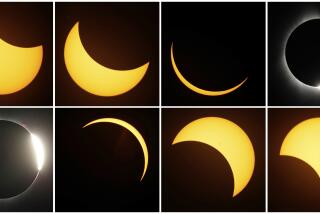A trick of the eye or a real flash in the sky?
- Share via
On A SPRING evening in 1959, I was standing on the edge of the Pacific Ocean -- Venice Beach, to be precise -- waiting for the moment when the sun’s red disk disappeared below the horizon.
My eyes didn’t waver.
I was waiting for the green flash.
I had first heard about the green flash from a fellow graduate student at UCLA. It was, by his account, a brief blaze of emerald light sometimes seen as the sun is rising or setting. The effect sounded so elusive, so magical, I was determined to see it. Hence, my retina-searing stare at the last remnant of the day.
No luck. That evening. Or the next. Or the next. Pretty soon I grew tired of my nightly trek to the beach and lost interest. Maybe my informant was making it up.
Then I read an article about the green flash published in Scientific American in 1960 by the astronomer D.J.K. O’Connell, who explained the science of the flash and included photographs made at the Vatican Observatory near Rome. There it was, the big orange ball sinking into the Tyrrhenian Sea, gaily topped with a tam of green.
That was that. I knew I had to see it, and so began a 30-year quest. I looked for the flash from cliff tops in the west of Ireland, as the sun dipped into the Atlantic. I gazed across dusty deserts in the Australian outback to the place where I knew the sun would rise like a huge, red balloon. I sat in seaside bars in Key West watching sky-filling sunsets with other patrons; only I had a secret purpose -- the elusive flash of green.
Like solar eclipses, Saint Elmo’s fire or the northern lights, the green flash has a storied past. The ancient Egyptians, for instance, who watched sunrise and sunset over desert sands, imagined that the sun turned green during its nightly passage through the underworld: a golden falcon by day, a green wraith by night.
In more recent times -- until O’Connell’s research, at least -- it was widely assumed that the green flash was a subjective phenomenon or an optical illusion. Retinal fatigue was commonly held to be the cause of the flash. After looking into a brightly colored light, our eyes simply become tired, and upon looking away, we see the complementary color.
Of course, retinal fatigue doesn’t explain why the flash is also seen at sunrise.
O’Connell proved the subjective theories false by obtaining color photographs of the flash. And he provided an alternate theory: As the sun rises or sets, its light strikes the Earth’s atmosphere at an oblique angle and passes through a great thickness of air. The atmosphere causes the light rays to bend upward, in the same way that light bends when it passes through a prism. The degree of bending determines the color: Violet rays are deflected most, red rays least.
When the sun sets, you would expect its colors to disappear over the horizon, one by one -- red first, violet last. But the orange and yellow rays are absorbed by the water vapor and the oxygen and ozone in the atmosphere, and the blue and violet rays are scattered out of the path of the light by bouncing off molecules of air. Other than red, the color least affected by passage through the atmosphere is green, and that is what -- briefly -- the observer sees.
It is a dazzling production, a bit of natural wizardry, a marvel of optical legerdemain.
And for 30 years I didn’t see it.
But I saw lots of other things. I saw skies awash with color like paintings by Turner. I saw little Mercury dart back and forth around the sun. I saw Venus -- the morning star and evening star -- blazing in dawn and dusk. I saw the sun grow fat and red as it slipped into a sea of gold. I saw the sun rise from desert sands like the eye of some Egyptian god.
And still nothing.
But what did it matter? Sunrise and sunset are the times of day when nature pulls out all the visual stops. I mean, where would I rather be than watching this chromatic display with or without this emerald capper?
Still I wrote about my search for the green flash. And I heard from people who had seen it, who even sent me their photographs, who invited me to come sit on their seaside decks and watch it with them.
Then, finally, not so many years ago, I got my own seaside bungalow on an island in the tropics. We built a porch off the bedroom facing the sunrise and called it the Green Flash Porch. Now, every morning I could watch for the elusive illumination.
Which I did. And it came. The first time I had to blink to make sure my eyes weren’t deceiving me. But no, it was there, the blaze of green. Now, I’ve seen the green flash dozens of times. I hardly bother to look any more.
Such is my loss.
“What makes the desert beautiful,” the Little Prince in Antoine de Saint-Exupery’s tale said to his pilot, “is that somewhere it hides a well.” The green flash was my hidden well.
Chet Raymo is the author of “An Intimate Look at the Night Sky.” His website is www.sciencemusings.com.
More to Read
Sign up for The Wild
We’ll help you find the best places to hike, bike and run, as well as the perfect silent spots for meditation and yoga.
You may occasionally receive promotional content from the Los Angeles Times.






